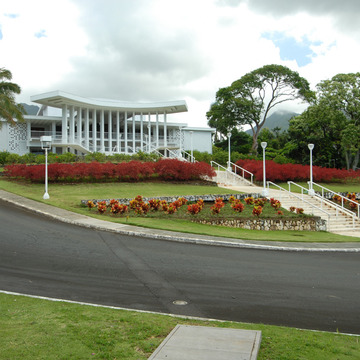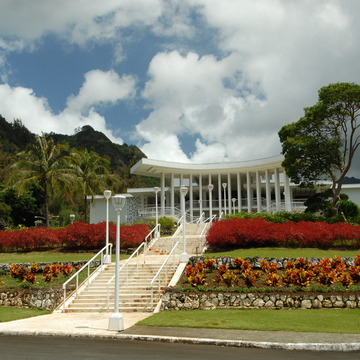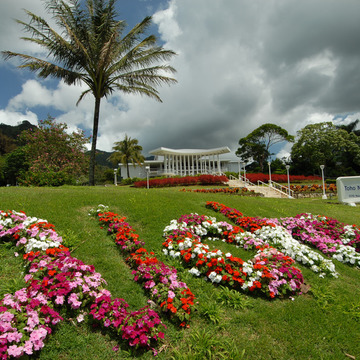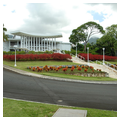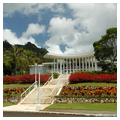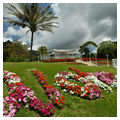You are here
MOA Hawaii, Hawaii Zuisenkyo True Health Center (Church of World Messianity [MOA])
Sited on a prominent, colorfully planted, three-acre terraced lot, gleaming white and symmetrical, the MOA Hawaii building combines classical and modern elements with traditional Japanese ones. The two-story, hollow-tile building offers a variety of textures and lines, which center on the prestressed-concrete, curved portico supported by a colonnade. The colonnade's fourteen piers symbolize the precepts of the Church of World Messianity. A spiral double-return stair with a wrought-iron railing draws the eye to the entrance and its second-floor lanai. Brick wings with blind, grillelike, hollow-tile panels offer horizontal balance, contrasting texture, and further visual relief. The asymmetric voids in the panels were intended to remind church goers of the chaos and human suffering in the world. A waffle pattern in the ceiling of the lanai is repeated on the eaves and the interior's side aisles, creating an indoor-outdoor dynamic beyond the nave's sliding glass and louvered walls. The shallow hyperbolic curved roof reiterates the visual uplift of the portico. The former altar end remains readily recognizable, defining the second-floor main hall's rear wall. A clean-lined elevated space, the former chancel is discreetly detailed with a paneled wainscot, shallow circular apse, and a pair of tokonoma (a niche or alcove for displaying a floral arrangement or art)–like niches.
Although built for the Church of World Messianity, MOA has used the location for the Hawaii Zuisenkyo True Health Center since the 1990s. This organization follows the ideas of Mokichi Okada (1882–1955) of Japan, who strove to establish world beauty. The basis of his thought emphasizes the use of natural health foods, the Jorei methods of curing illness, and the promotion of beauty through the arts and flowers. Thus the building and the front garden play their part in fulfilling Okada's ideals.
Writing Credits
If SAH Archipedia has been useful to you, please consider supporting it.
SAH Archipedia tells the story of the United States through its buildings, landscapes, and cities. This freely available resource empowers the public with authoritative knowledge that deepens their understanding and appreciation of the built environment. But the Society of Architectural Historians, which created SAH Archipedia with University of Virginia Press, needs your support to maintain the high-caliber research, writing, photography, cartography, editing, design, and programming that make SAH Archipedia a trusted online resource available to all who value the history of place, heritage tourism, and learning.


